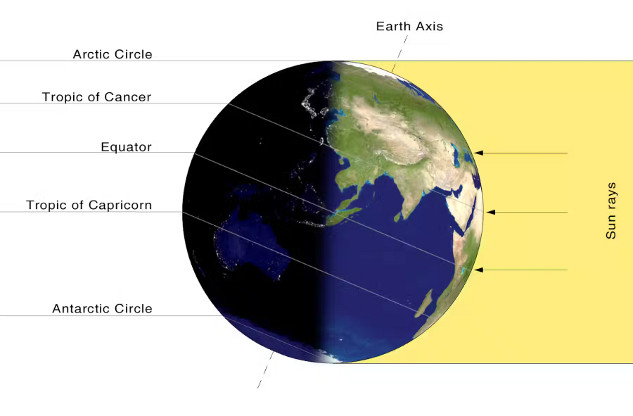
Den nordlige halvkugle får sin største dosis dagslys. Takmeng Wong og CERES Science Team ved NASA Langley Research Center, CC BY
Sommersolhverv markerer den officielle sommerstart. Det bringer den længste dag og korteste nat på året for 88 % of Earth’s people who live in the Northern Hemisphere. People around the world traditionally observe the change of seasons with bonfires and festivals and Fête de la Musique-fester.

Solstice er den 24-timers periode i løbet af året, hvor mest dagslys rammer den nordlige halvkugle. Przemyslaw 'Blueshade' Idzkiewicz, CC BY-SA
Astronomers can calculate an exact moment for the solstice, when Earth reaches the point in its orbit where the North Pole is angled closest to the sun. That moment will be at 10:58 a.m. Eastern Time on June 21 this year. From Earth, the sun will appear farthest north relative to the stars. People living on the Tropic of Cancer, 23.5 degrees north of the Equator, will see the sun pass straight overhead at noon.
Six months from now the sun will reach its southern extreme and pass overhead for people on the Tropic of Capricorn, and northerners will experience their shortest days of the year, at the winter solstice.
Solens vinkel i forhold til jordens ækvator ændrer sig så gradvist tæt på solstice, at forskydningen uden instrumenter er vanskelig at opfatte i ca. 10 dage. Dette er oprindelsen til ordet solstice, hvilket betyder "solstop".
Dette langsomme skift betyder, at den 21. juni kun er cirka 1 sekund længere end den 19. juni på de nordlige breddegrader. Det tager cirka en uge, før der ændres mere end et minut til den beregnede dagslysmængde. Selv det er en tilnærmelse - Jordens atmosfære bøjer lys over horisonten i forskellige mængder afhængigt af vejret, hvilket kan introducere ændringer på mere end et minut til solopgang og solnedgang.
Monumenter ved Stonehenge i England, Karnak i Egypten, og Chankillo in Peru reveal that people around the world have taken note of the sun’s northern and southern travels for more than 5,000 years. From Stonehenge’s circle of standing stones, the sun will rise directly over an ancient avenue leading away to the northeast on the solstice. We know little about the people who built Stonehenge, or why they went to such great effort to construct it – moving multi-ton stones from rock outcrops as far as 140 miles away.
All this to mark the spot on the horizon where the sun returns each year to rest for a while before moving south again. Perhaps they, like us, celebrated this signal of the coming change of seasons.
Dette er en opdateret version af en artikel, der oprindeligt blev offentliggjort den 18. juni 2018.![]()
Stephen Schneider, Professor of Astronomy, UMass Amherst
Denne artikel er genudgivet fra The Conversation under en Creative Commons-licens. Læs oprindelige artikel.
books_awarness
























